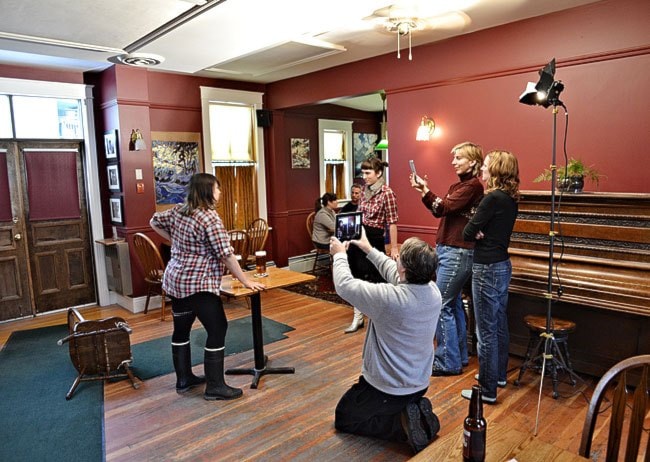Call it filmmaking on the cheap and easy. The super cheap and easy.
Using only iPads to shoot and edit, eight filmmakers in Dawson City recently produced two-minute dramatic shorts with the help of a first-of-its-kind course.
The brainchild of filmmaker Richard Lawrence, the course was offered through the Klondike Institute of Art and Culture with Yukon College’s Technology Innovation supplying the pencil-thin computers for the students.
Dawson was chosen as the place to put it on in part because of its appetite for filmmaking.
The course’s eight spots were quickly snapped up, said Karen Dubois, KIAC’s executive director.
The students who did get in had only about 48 hours, over two weekends, to create the two-minute films.
Veteran filmmaker Lulu Keating, who was one of the lucky eight, said she loved the challenge.
“And he (Lawrence) set another challenge for us too - he wanted dramas,” she said.
Without a compelling story, there is little point to make a movie, said Lawrence.
“You can’t really make a good drama without a good story,” he said. “If you have a really boring story with fairly nondescript or boring characters, it’s unbearable to watch.”
It was the idea to focus on the story that led Lawrence to come up with the idea of making a film completely on an iPad.
“When you’re working with something as simple - in technological terms - as an iPad or a tablet that has very limited software capabilities, you have to focus on something else to grab people,” he said.
A common, film-editing software called Final Cut Pro can take weeks to learn whereas iMovie can be learned in a half an hour, Lawrence said.
People in filmmaking courses often get distracted with special effects and techno tricks, he said.
“Often the technology gets in your way. I wanted to find a device where the technology didn’t get in your way,” he said.
For some students the simplicity of the movie-making software and technology was frustrating at times. Many are at varying stages of professional filmmaking careers.
It was quite a steep learning curve for some of the class, said Keating.
And there were some challenges few would have predicted.
“We did some outside shooting on the street and that’s when you realize with these touch-pads that rely on the heat of your finger, you’ve got to keep your finger warm or else they don’t work,” Keating said, chuckling. She had a hole in her mitt that caused some troubles.
But for most negatives, there seemed to be a positive with the little, all-in-one devices.
“There was anonymity,” said Keating.
Without big budgets for actors, extras and sets, the ability to film a room of people with few noticing was a big advantage.
Usually once the lighting equipment is set up, the microphones are synced in and the infamous red light in the front of the camera turns on, the room often goes “camera shy.”
But with iPad filmmaking, that doesn’t happen.
The course’s participants used minimal lighting and sound equipment, if any.
The tablet’s ability to hold white balance, focus and exposure, and pick up sound is fairly decent, Lawrence said.
And once everything is filmed, there is no editing booth or studio charges. Everything is done on the iPad, with the touch of fingers.
And it’s portable.
Anywhere you can reach your arms, you can get the shot.
But the quality of the product is undeniably lower than when using conventional gear. Even though Keating got to take home her iPad after winning the course’s draw, she doesn’t think she will use the device when shooting professional films for her company, Red Snapper Films Ltd.
However, she does think she will definitely use it for the “grunt work” of filming such as scouting out locations.
That’s one task major filmmakers in the industry are already using iPads for, said Lawrence. Some even use the device to film B-roll.
“It does a pretty good job, considering the software,” he said.
Lawrence isn’t sure if he’s ready to trade in his video camera for an iPad just yet either.
“I’d like to see the software improved,” he said. “There’s just a few glitches but it has potential.”
The films made during the iPad filmmaking course explored a range of stories from gambling to loneliness to peanut butter-marshmallow sandwiches.
The films priemiered in Dawson City at the end of the course and are scheduled to be screened in Whitehorse in the new year.
Both KIAC and Yukon College hope to offer the course again, but nothing has been scheduled yet.
The iPads have been divided between the college in Whitehorse and KIAC in Dawson and are available for rent.
Both institutes are looking forward to seeing what ideas other people may have about courses that can be offered with an iPad.
Contact Roxanne Stasyszyn at
roxannes@yukon-news.com
